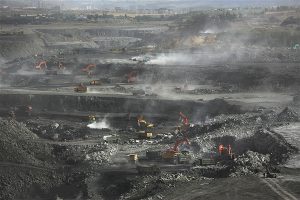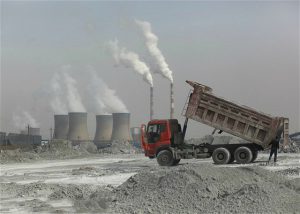China’s National People’s Congress wrapped up March 15 and once again the government sent a clear signal about how seriously it takes the need to scale back new coal-fired power.
Premier Li Keqiang delivered a closely watched report on the government’s work on March 5, stressing that 2017 would see an additional 50 gigawatts or more of coal-fired power capacity closed down, halted or postponed.
In early March every year some 3,000 People’s Representatives from around the country gather in Beijing to discuss policy and law-making issues. One of the highlights of these meetings is the report on the government’s work, presented by the premier of the State Council.
This year’s report was the first to include a clear figure on the reduction of coal power capacity, indicating that the process will be a focus of China’s economic reforms in 2017.
The move may not come as a big surprise to a sector that has already seen significant reform efforts. The National Energy Administration halted 120 gigawatts of capacity (both under construction and planned) in the latter half of 2016. Although the latest announcement is vague on details, it means that 170 gigawatts – one sixth of all China’s coal-fired power capacity – may be either shut down, or in the case of planned capacity, not get built.
The coal-power money pit
The aggressive policy measures to limit coal capacity have been put in place to address the short term risks to China’s coal-fired power sector that have emerged in the past few years. As growth in energy demand has stalled, the sector is faced with a huge overcapacity problem.
But while the government’s clampdown on coal power has created significant uncertainty for investors, it is also a means of reining in new capacity and reducing the risk of future asset stranding.
This risk is quite serious according to a report from Oxford University released in February. The research weighed up the various risks to coal utilities and calculated that in the worst case scenario investors in coal power may lose between 3,086 and 7,201 billion yuan (US$449-1,047 billion), equivalent to 4.1% to 9.5% of China’s 2015 GDP.
The report from the Smith School of Enterprise and the Environment looked at coal-fired power stations owned by China’s top 50 coal-fired power utilities that are operating, planned, or under construction. Together, they account for 89% of China’s coal-fired power capacity. The report calculated the “stranded assets” that would result if all those plants were closed down over the next 5, 10 or 20 years.
The scenarios may appear quite extreme given that coal-fired power plants have an average lifespan of 35 years and the average age of the power plants examined in the survey was less than 10 years old. But there are plenty of reasons why coal-fired power assets could face early closure or financial losses, not least surplus coal-fired power capacity, slowing growth in demand for power, development of renewables and, of course, the urgent need to address climate change by reducing source emissions.
But some Chinese experts disagree with the report’s data.
Yuan Jiahai, professor at North China Electric Power University, told China Dialogue that during the 13th Five Year Plan period (FYP) from 2016 to 2020, China will cap coal-fired power at 1,100 gigawatts – less than the 1,800 gigawatts of total capacity that the report assumes.
Yuan also said that the report’s figure of 563 gigawatts for coal-fired power capacity currently being planned is far above the domestic industry’s own figure, which has been brought into line with the coal power cap announced in the 13th FYP.
“The industry thinks at most 350 gigawatts of extra capacity will be built; 200 gigawatts have already been approved, the remaining 150 may or may not be approved,” said Yuan.
He says the large discrepancy is because some companies have carried out planning but not completed the approvals process, and so this capacity has not been included in domestic figures. Given that government efforts to curb overcapacity in the coal sector are relatively recent (late 2016 and early 2017) many coal plants in the planning process are unlikely to receive approval.
Although the exact figures are subject to change and dispute, there is no doubt that the coal sector faces the possibility of asset stranding if it fails to take into consideration long term trends.
The Oxford study is not the first report to look at investment risks in China’s coal power sector; a report from Carbon Tracker in 2016 predicted that US$500 billion of coal-power assets were at risk of stranding.
Yang Fuqiang, senior adviser on energy, the environment and climate change at the Natural Resources Defense Council (NRDC), told China Dialogue that the country is likely to require less than the 1,100 gigawatts in the 13th FYP. NRDC research finds that rapid growth in renewables deployment means China could improve on the planned coal capacity cap by some 140 gigawatts, with only 960 gigawatts of coal-fired power by 2020.
Even if demand does increase after 2020, further renewables growth and an increase in operating hours for existing coal-fired plants will make new coal-fired power unnecessary. In 2016, China’s coal-fired power plants operated for only 4,165 hours on average, which is much below the normal figure of between 5,000 and 5,500 hours, which is used by the sector as the threshold to determine that more capacity is required. A figure below 4,500 hours suggests there is surplus capacity.
Avoiding losses
It’s important to remember who will foot the bill for coal asset stranding. “95% of coal-power assets are state-owned, which means the government cannot abandon them,” Yuan Jiahai told China Dialogue. Given the state monopoly on coal power, industry losses will ultimately fall on taxpayers.
According to Yang Fuqiang, cancelling projects that are approved or under-construction is the best way to prevent losses later on. China is already closing six gigawatts of small scale coal-fired power every year and replacing it with capacity from other sources. If older plants that have already recouped their investment are targeted in this process, there will be a lower risk of industry losses.
Given the more restrictive policy environment, companies will also need to plan effectively.
“The more foresighted companies are already taking action,” Yuan said. He’s spoken to firms and found some, such as SDIC Power, are already disposing of coal-fired power assets. China’s five major power companies are much less inclined to invest in new capacity and are speeding up divestment from some old or poor quality assets.
The state-owned companies do not operate on open markets though, and have little appetite for transitioning out of coal power. But as China continues to reform its electricity system – a challenging process without a clear timeline that will eventually end planned generation and unified pricing – the companies will have to adapt to a sector that is more market-based. This poses a major challenge for the coal-fired power sector, which is accustomed to benefitting from planned generation and guaranteed purchases.
Yuan Jiahai thinks that if electricity market reforms result in lower prices for coal power then new investment will drop off, reducing the risk of stranded assets.
Yuan points out that the 13th FYP for the electricity sector also provides some new opportunities for coal-fired power within the overall 1,100 gigawatt coal cap, such as in combined heat and power generation and district heating schemes, and flexibility retrofits to allow existing plants to regulate peak demand to better integrate wind and solar generation. These measures could mean that a use is found for 219 gigawatts of coal-fired power in the new energy structure.
But Yang Fuqiang thinks that companies should start pulling out of coal-fired power now. He says that electricity sector reforms, flexibility retrofits, and the need to reduce carbon emissions will actually increase costs and make conditions increasingly difficult for coal.
And in the long term there’s little scope for coal power anyway. “By 2050 coal will account for 16-17% of total energy use in China – even if 80-90% of that is for power generation, that’s only 500-600 gigawatts,” Yang pointed out.
The question is how quickly the move away from coal will be. Both Yang and Yuan think the state can provide the coal sector with a buffer through price subsidies that will soften the blow of mass lay-offs and maintain social stability.
David Robinson and Li Xin of the Oxford Institute for Energy Studies also argue that further subsidies may be unavoidable. In a review of international experiences closing coal-fired power plants, they suggest that, “in the interest of encouraging early closure of coal-fired generation, or retrofitting of CCS for relatively new and efficient plants, China may wish to consider some form of financial compensation to affected shareholders.”
The government’s latest announcement is a positive step but as prospects for the coal sector look unlikely to improve, and risks of asset stranding become clearer, it remains to be seen whether the government will have to take additional action.








